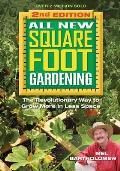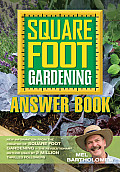
Why is the government teaching us to waste water? I'm asking you because I'm talking about your garden.
The fact is, the gardening practices that are endorsed and taught by the U.S. government and the Department of Agriculture make extremely inefficient use of water. How can this be possible when, as of February 1, 2013, more than 60 percent of the contiguous United States was classified as under drought conditions? Water is becoming scarcer by the day. We ought to be looking for new ways to conserve it. Even gardeners in historically water-rich states like Oregon and Minnesota have a responsibility to manage this resource: water scarcity is a fact of life everywhere.
So how does the government tell us we should garden? First, let's consider how most gardens are planted and then watered. The average home garden is about 20 feet by 35 feet, for a total area of 700 square feet. Rows for planting are spaced 3 feet apart. Typically, you'll have about ten 20-foot-long rows for all of your different crops. You may start your season with a row each of carrots, lettuce, Swiss chard, radishes, beets, and marigolds. Then, for summer, you might add rows of bush beans, peppers, eggplants, tomatoes, squash, and all the other good things you want in your garden. This is called row gardening or the single-row method, and it is the prescribed approach found most often in the literature and position papers produced by the U.S. government.
The single-row method of gardening that rules most backyard gardens is rooted in hand-me-down practices from long-gone generations. About 70 years ago, the War Department renamed the row gardens they asked us to grow in our yards and empty lots "victory gardens." The victory gardens (the name actually came from Great Britain) went a long way toward helping to feed our hungry nation during a time of war and hardship. But they also helped cement the practice of row gardening into our national heritage.
Times have changed. With all the new advances in technology and green living, how is it that our own government still teaches and promotes the wasteful practice of row gardening?
When I was around 10 years old and the world was smack-dab in the middle of victory gardening, we did not really have an alternative. We had not gotten around to asking important questions like: Why do we plant rows 3 feet apart? And, why do we plant 100 heads of lettuce only to waste most of what is planted?
How Do You Water Your Garden?
One very popular answer is with a portable sprinkler system you attach to a hose and move around. Some might even have an underground sprinkler system like the ones you use for your lawn. The last resort of most gardeners is standing alone in the garden, swinging a hose back and forth until you're too tired to go on or you manage to convince yourself that you have watered long enough. The trouble with these approaches is that you're watering everything, even the 3-foot-wide walking aisles that USDA practices suggest we leave between the rows of plants. And what is growing in those aisles? Anything you find edible or planned on harvesting? Nope — WEEDS. In these arid times, why are we being told to water weeds?
The wasteful watering practices don't end there. Another crucial problem is that to get water to the plant roots where it is needed, you've got to spray the entire plant and then hope water trickles down into the soil and the roots where it is needed. You don't really know how much gets into the roots, but if you water long enough, it might work. What a terrible waste of water.
Another popular but inefficient watering technique is the pioneer-era method called irrigation, which is still used today. In this scheme, you flood the whole garden area. Although the plant rows are sometimes built up just a little bit to channel water to the plants, the aisles are still flooded with water. Some of the water will sink into the soil sideways to the plant roots. But besides that, it gets awfully muddy and you can't work in your garden until it dries out. Talk about wasting water.
 I've given you several examples of watering techniques that are common practice today but are very inefficient. What if we followed another path and stopped believing the mythology? What if we stopped watering this way?
I've given you several examples of watering techniques that are common practice today but are very inefficient. What if we followed another path and stopped believing the mythology? What if we stopped watering this way?
- If you don't water the 3-foot-wide walking aisles, you would save at least 40 percent of your water. That's a huge savings and well worthwhile, but you just can't do that using irrigation, sprinklers, or overhead hose watering.
- If you eliminate watering from the top down, you'll save another 40 percent of your water consumption.
- If you could apply the water to just the root area, you'd save another 10 percent for a total reduction of 90 percent.
So What Should We Do Instead?
Well, there are many ways to garden that eliminate all or some of the water waste that is unavoidable with traditional row gardening. One way (and it is my personal favorite) is Square Foot Gardening (SFG). SFG is an approach to home gardening that I first developed in the 1980s. It has drawn literally millions of followers since then. The second edition of my book, All New Square Foot Gardening from Cool Springs Press, has just been published. The whole method, and then some, is described in full detail there. But for our purposes, here is how SFG can reduce your garden water consumption to 90 percent of what you use in row gardening.
How We Water an SFG
The ideal way to water your square foot garden is by hand from a bucket of sun-warmed water. We ladle out a cupful and pour that around the base of each plant. When the plants get bigger, you use one hand to lift the lower leaves and then pour the water right onto the root area. Bingo — 100 percent efficiency! No wasted water! That sun-warmed water doesn't shock the plants like hose water does, and all of the chlorine in your city water has evaporated overnight in the bucket. Large plants get two cups of water, while smaller ones need just a ½ cup. We give the plant what it really needs and no more. We call this nurturing. We treat our plants just like children. You wouldn't give the same size cup to a teenager versus a young child? Of course not. It's just common sense. Yet in row gardening, we give everything and everyone the same amount. That's not very smart or efficient, is it?
I can just hear all the experts saying, "That's too much work and it takes too long." Well, let me tell you, it will work. I did some time and motion studies and found that lovingly ladling sun-warmed water takes just about the same amount of time as lugging out a hose, hooking it up, turning it on, standing there spraying everything with cold, chlorinated water, and then finally having to put everything away.
One great side effect of using the SFG watering method is that you get close to your plants as you are watering them. You see all the little interesting things about the plant as it grows: new blossoms coming on those bush beans, caterpillar holes on the cabbage leaves before it'